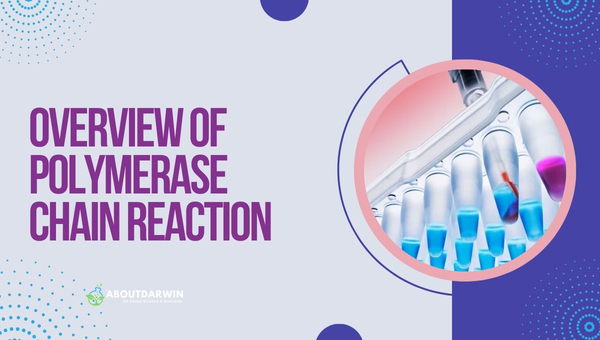Physical Address
304 North Cardinal St.
Dorchester Center, MA 02124
In today’s science-driven world, it’s hard to ignore the astounding contributions of certain tools and techniques that have made significant strides in understanding the complex fabric of life. One such revolutionary technique is the Polymerase Chain Reaction, commonly known as PCR.
Introduced in the 1980s by Kary Mullis, this technique has completely transformed areas like genetic research, medical diagnosis, and forensic science. It allows us to amplify minimal amounts of DNA and obtain millions or billions of copies in just a few hours.
In this blog post, we’re going to delve into PCR’s principles, procedures, types, applications and how animations can make learning about this complex process much easier. Let’s dive in!
Contents
The Polymerase Chain Reaction (PCR) is a fast and inexpensive technique used to “amplify” – copy-specific segments of DNA.

Since its development in the 1980s, PCR has become a common method used in medical and biological research labs for tasks including:
In simpler words, if we consider DNA as an individual recipe within a cookbook (genome), PCR allows us to make multiple copies of that particular recipe quickly. The essence of PCR lies in its simplicity and effectiveness, which makes it an invaluable tool in genomics studies.
Given its myriad applications and significance, understanding how PCR works not only opens avenues for scientific exploration but also enhances our understanding of life’s blueprint – DNA.
Also Read: Proteus Mirabilis: Understanding Biochemical Identification
The invention of PCR was a game-changer in the scientific and medical fields. Let’s dig deeper to understand why it holds such a pivotal position:
In essence, due to its versatility combined with time efficiency and cost-effectiveness, PCR continues to be an indispensable tool for modern biology! The amazing thing about this method is that it continues evolving with new modifications being added over time- a testament indeed that science never sleeps!
Now that we know what PCR is and why it’s so crucial, let’s unravel the magic that happens behind the scenes.
PCR can be thought of as a biological photocopier. It starts with a DNA sample, which contains the segment you want to replicate (Target DNA). The principles behind its functioning are as simple to understand as they are cool to learn about!
Firstly, it involves heating up our genetic material to separate the two strands of DNA—we call this denaturing. Then comes annealing, where short pieces of DNA called primers attach themselves to specific sections on each strand.
Now enter our superstar molecule—Taq Polymerase—a heat-stable enzyme obtained from bacteria living in hot springs that synthesizes (“builds”) new strands of DNA using nucleotides, starting at those primers.
Viola! We end up with two exact copies of our original target DNA segment. And guess what happens when we initiate another cycle? These two copies multiply into four. Repeat this for about 30 bikes, and brace yourselves for over a billion duplicates!
Are you ready for some more juicy details? Believe it or not, everything we’ve discussed so far wouldn’t be possible without a few other key elements making all the difference in a PCR reaction:
Hold on, though! The most important component of all? Undeniably, you, the curious mind, are eager to discover more about life’s greatest puzzles! Kepler once said, “Truth is the daughter of time, not authority.” So give yourself a pat on your back. You’re now well on your way to mastering one of modern biology’s most successful techniques!
Are you ready to put your knowledge into action? Let’s walk through how to perform a PCR test and solve common problems that may arise!
Here’s how you perform a basic PCR Test:
Bingo! You just made millions of copies from just a single piece of target DNA!
Like all things in life, this process isn’t always perfect—it comes with potential issues that you may encounter:
No Amplification or Low Yield
Possible fixes: Check for degraded primers or template DNA; make sure your dNTPs are properly preserved as they’re susceptible to repeated freeze-thaw cycles; Confirm that MgCl2 concentration is optimal—remember, too little reduces activity, but too much will cause non-specific amplification!
Non-specific Amplification
Possible fixes: Adjust annealing temperature; use hot-start PCR that enables Taq Polymerase only after the initial denaturation; optimize your buffer conditions.
Through problem-solving techniques like these, you can tackle issues head-on and keep your PCR procedure running smoothly. As with any scientific protocol, practice makes perfect—and as you move forward in your journey, you’ll be a PCR pro before you know it!
Also Read: Proteus Mirabilis: Understanding Biochemical Identification
As marvelous as PCR is, its true beauty lies in its versatility. PCR has sprouted into various types over the years— each with its unique advantages, aims, and methodology. Here’s a look at some major ones:
Real-Time PCR (RT-PCR): An offshoot of traditional PCR that monitors the amplification process in real-time. It’s like peeping into the action as it unfolds! It is used primarily for quantifying the amount of DNA (or transcript levels) in a sample.
Reverse Transcription PCR (RT-PCR): Confused already? Here’s an easy tip – if you think ‘RNA’, think of this type of PCR! Yes, RT-PCR works on RNA templates to produce corresponding DNA copies or ‘cDNA’. This is super handy for studying gene expression.
Multiplex PCR: Imagine standing in line at your favorite ice cream joint; there are so many flavors to choose from, but you can only pick one. Well, Multiplex-PCR feels your pain! Its power is that it allows us to amplify many different DNA fragments simultaneously using multiple sets of primers – thus saving time and resources.
Nested PCR: Nested here means two consecutive PCRs performed on the same sample with two sets of primers where the second set is intended to anneal within the first set product, increasing specificity.
Choosing the right type revolves around understanding what exactly we’re aiming to achieve from our experiment. Need qualitative data on specific genes or looking for accurate quantification? RT-PCR might be our go-to! Are we studying expression levels via RNA instead? The best bet could be reverse transcription!
We must match our experimental design with the most suitable variant. Again, remember – no rush, champ; patience was never wasted when chasing truth!!
While PCR’s principles and procedures are intriguing, its real charm lies in the wide-scale applications it offers. So buckle up as we explore how PCR helps decipher mysteries spanning from our cells to the cosmos!
PCR has proved to be a boon in healthcare for both identifying pathogens and unraveling our genetic mysteries:
Apart from these medical wonders, let’s look at some fascinating use cases that bring light to PCR’s versatility:

Forensic Science: Remember O.J. Simpson’s trial? A landmark case is putting forensic science under public scrutiny—specifically forensic DNA analysis performed using old-school RFLP technology, which requires a relatively large amount of DNA.
Enter PCR! It transcended this limitation, given its ability to amplify minuscule amounts of DNA (say hair follicles or blood droplets)—making it an ideal choice for crime scene investigations ever since!
Paleontology: Ever wondered how scientists study ancient extinct creatures like Neanderthals? Spoiler Alert: They time-travel with help from ancient remains and…you guessed it! Our dear old PCR! It comes to the rescue, amplifying small amounts of DNA found in these remains.
Astrobiology: From Earth’s crust to Mars exploration, PCR is helping astrobiologists detect signs of life in the most extreme habitats—stretching our vista about where life as we know it can exist!
So, from fighting diseases on home turf to exploring life boundaries beyond Earth, PCR indeed continues reshaping how we perceive and interact with the world around us. And might I say that’s incredibly exciting? Because it certainly feels so!
Also Read: Forestry Career: What Do Foresters Do and How to Become One?
While scientific understanding is indeed profound, sometimes those long, strenuous hours of poring over complex processes can take a toll. But fear not! Animations provide a dynamic and interactive way to grasp those interlaced concepts of PCR!
Think about it: Science itself is so full of motion and transformation. Doesn’t it make sense that its learning should be dynamic, too? Well, it turns out that animations can help you visualize what’s going on at the molecular level during PCR in a way textbook diagrams simply can’t!
From observing how temperatures affect DNA’s double helix structure to watching TAQ add nucleotides at the primer site – seeing these elements in motion can do wonders for comprehension.
What’s more, visual aids like animations aren’t just appealing to the eye—they’re incredibly potent tools that enhance memory and recall. Because let’s face it—who wouldn’t prefer watching mesmerizing animations over muddling through thick textbooks?
Luckily for us, we’re living in a digital era where a number of high-quality scientific animations are just a click away!
Here are some brilliant platforms that offer clear, animated explanations about PCR:
Khan Academy: The institution needs no introduction! Their walkthrough video on ‘How does PCR work’ simplifies this complex process impressively via kinetic typography and nice visuals.
DNA Learning Center (DNALC): DNALC provides an array of educational resources, including an enriching animation depicting the PCR process at the molecular level.
YouTube Channels: Platforms such as “Amoeba Sisters,” “ZeroBio,” and “Science with Susanna” provide quick yet enriching animated explanations on PCR—making them fantastic platforms to aid your studies!
Just remember while learning—stay patient with yourself, remain driven by your curiosity, and above all, enjoy the process! Because truly understanding PCR—or any other aspect of biology—is like unlocking a tiny bit more of life’s greatest mysteries. Isn’t that a worthy adventure? I bet you’re nodding your head. Happy learning!
PCR is based on using the ability of DNA polymerase to synthesize new strands of DNA complementary to the offered template strand.
The general formula starts with an initial denaturation step at 94 °C to 98 °C, depending on the optimal temperature for DNA polymerase activity and G-C content of the template DNA.
A primer, as related to genomics, is a short single-stranded DNA fragment used in certain laboratory techniques, such as the polymerase chain reaction (PCR).
Polymerase chain reaction (abbreviated PCR) is a laboratory technique for rapidly producing (amplifying) millions to billions of copies of a specific segment of DNA, which can then be studied in greater detail.
Taq DNA polymerase is the most common enzyme used for PCR amplification. This enzyme is extremely heat resistant, with a half-life of 40 minutes at 95°C.
In conclusion, the Polymerase Chain Reaction, or PCR as we now know it, has redefined our approach to studying life’s most complex blueprint – DNA. Its principle of heat-induced replication, neatly harnessed in lab settings, has empowered us with a potent tool capable of amplifying sections of our genome.
As we skimmed through its variants like Real-time PCR and RT-PCR, appreciated its applications from health diagnosis to astrobiology, and even cracked open its troubleshooting toolkit, I hope you’ve gained insights into this life-altering technique. Remember that learning about PCR isn’t just about understanding a scientific process; it’s more importantly about appreciating humanity’s journey towards unlocking nature’s intricate designs— one DNA strand at a time. So here’s wishing you many more enlightening discoveries in your journey ahead!